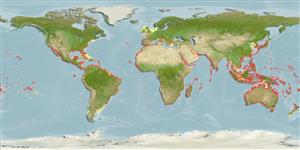Hypnea valentiae (Turner) Montagne
| Native range | All suitable habitat | Point map | Year 2050 |

|
| This map was computer-generated and has not yet been reviewed. |
| Hypnea valentiae AquaMaps Data sources: GBIF OBIS |
Upload your photos
Google image |
No photo available for this species.No drawings available for Hypneaceae.
Google image |
No photo available for this species.
Classification / Names Common names | Synonyms | CoL | ITIS | WoRMS
Florideophyceae | Gigartinales | Hypneaceae
Environment: milieu / climate zone / depth range / distribution range Ecology
Sessile; depth range 0 - 33 m (Ref. 102653). Tropical
Distribution Countries | FAO areas | Ecosystems | Occurrences | Introductions
Atlantic Ocean: from North Carolina, USA, to the Caribbean, south to Brazil, east to Herault, France, including Bermuda, Salvage Islands and the Mediterranean; in the Canary Islands, south to São Tomé and Príncipe, including Cape Verde Islands. Indian Ocean: from the Arabian Sea south to Madagascar, including the Red Sea, Persian Gulf, Oman Sea, Aldabra Islands, Seychelles, Reunion and Mauritius, east to India and south to the Andaman Sea; in Australia, from Western Australia to Victoria. Pacific Ocean: in the Philippines, Viet Nam, Federated States of Micronesia and Fiji, east to California including the Hawaiian Islands, and south to Peru.
Length at first maturity / Size / Weight / Age
Maturity: Lm ? range ? - ? cm
Life cycle and mating behavior Maturity | Reproduction | Spawning | Eggs | Fecundity | Larvae
In India, H. valentiae showed seasonal peaks of tetrasporophytes in winter months and cystocrpic plants in summer months, while male plants where always rare (Ref. 82232).
Main reference
References | Coordinator | Collaborators
Guiry, M.D. and G.M. Guiry. 2009. (Ref. 80701)
IUCN Red List Status (Ref. 130435: Version 2024-1)
CITES status (Ref. 108899)
Not Evaluated
CMS (Ref. 116361)
Not Evaluated
Threat to humans
Human uses
| FishSource |
Tools
More information
Trophic Ecology
Food items
Diet
Food consumption
Ration
Predators
Diet
Food consumption
Ration
Predators
Ecology
Population dynamics
Life cycle
Distribution
Human Related
Aquaculture profile
Stamps, Coins Misc.
Stamps, Coins Misc.
Outreach
Taxonomy
References
Internet sources
BHL | BOLD Systems | CISTI | DiscoverLife | FAO(Publication : search) | Fishipedia | GenBank (genome, nucleotide) | GloBI | Gomexsi | Google Books | Google Scholar | Google | PubMed | AlgaeBase | Tree of Life | Wikipedia (Go, Search) | Zoological Record
Estimates based on models
Preferred temperature
(Ref. 115969): 17.8 - 29.1, mean 27.5 (based on 5807 cells).


